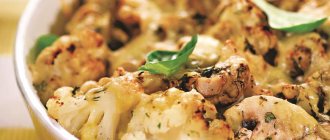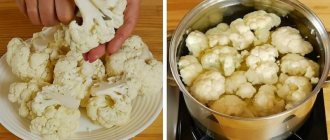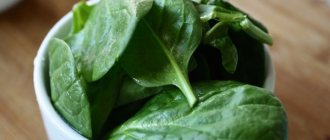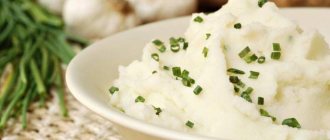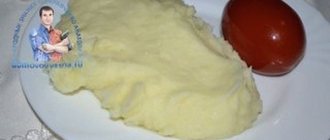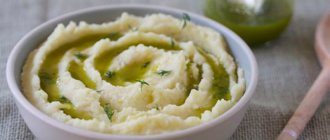Cauliflower puree is a low-calorie product that can be introduced to infants from an early age. There are more than 10 recipes based on this vegetable. Usually it is mashed with cauliflower and carrots, potatoes or pumpkin. You can prepare the first complementary food from a hypoallergenic product in a double boiler or slow cooker. When processed with steam, maximum nutrients are retained. Cooking times vary. There are no clear deadlines in this regard; the main thing is to achieve the ideal consistency. The puree should be homogeneous, without lumps, smooth.
Selection of vegetables
Cauliflower is sold in stores frozen or fresh. Frozen vegetables lose most of their beneficial microelements, so preference is given to unprocessed foods. During some seasons, it is impossible to find fresh cauliflower. To continue feeding your baby the product in this case, it is recommended to freeze the vegetable yourself.
During the “seasonal” time, it is easy to determine the suitability or unsuitability of cabbage, since it lies open on the counter. You should pay attention to the condition of the leaves and inflorescences (both color and the presence of deformations or pigments).
Reasons to refuse a purchase are:
- yellow inflorescences with a loose consistency;
- presence of pigments;
- torn leaves, mangled inflorescences;
- extensive darkened areas;
- mold;
- signs of plant disease.
The baby is very sensitive to new complementary foods, and if a harmful microorganism or stale product gets into it, this will lead to serious stomach upset. Therefore, the vegetable should be checked carefully before purchasing.
Product introduction time
At what month can you start giving cauliflower for the first time? The ideal period would be 6 months of age, but you can try starting earlier. In this case, you need to consult a doctor. There is no need for early introduction of complementary foods.
For children who are formula-fed, it is recommended to introduce the product earlier, up to 5 months.
The baby's first complementary food should be prepared for breakfast or lunchtime. How much cabbage puree is allowed to be given the first time? Half a teaspoon is enough. If there is no allergy, the dosage can be gradually increased to 40 g. How many grams can a child be given? At 7-8 months, the portion should be about 180 g. By one year, the baby should eat about 200 g of cabbage per day.
When your baby refuses a new product, you need to take a break and offer it again after a few days.
Self-freezing
The mother can freeze cabbage on her own, including for the winter. This will dispel doubts about the quality of the product and eliminate the presence of preservatives that are harmful to the child. This is done after a short pre-cooking, which eliminates the possibility of the product withering when frozen.
Before putting the vegetable in the freezer, you can chop it or cook it whole. Cabbage in pieces is easier to place, and whole cabbage does not require additional time spent on slicing. The algorithm for preparing and freezing both versions of cabbage is the same.
The vegetable is washed under running cold or warm water and thoroughly cleaned of all foreign pigments and particles. The leaves are separated from the inflorescences. The light part of the vegetable is immersed in boiling, slightly salted water. It is not recommended to add salt during cooking for further preparation of puree. If the vegetable is prepared for subsequent freezing, this ingredient serves as a preservative and does not harm the child.
Keep whole cabbage in an enamel pan for 10 to 15 minutes, shredded or blanched cabbage for 5 to 10. You need to soften the product, but not so much that it begins to fall apart or turn into mush. It should retain its shape and be easily transferred without losing particles.
After the specified period, the product is placed in a bowl of cold water, cooled and additionally washed to remove foreign particles. Then it is placed on a clean and dry towel. The vegetable must be dried so as not to spoil when frozen.
After this, the half-cooked cabbage can be placed in a plastic bag (also clean and dry) and left in the freezer for the required time.
Other varieties of cabbage as complementary foods
It is better to start complementary feeding with breakfast or lunch in order to track the baby’s reaction to the new product. The amount of vegetable puree on the first day of feeding is half a teaspoon. The vegetable mixture should be made liquid; this consistency is familiar to the baby. A couple of hours after breakfast you need to examine the baby.
If your child's cheeks turn red or spots appear, this indicates a food allergy to cauliflower. Allergies can also manifest themselves in the form of vomiting, diarrhea, general weakness and abdominal cramps. If one of the symptoms appears, it is better to postpone complementary feeding for some more time (2-3 weeks) and start it with another product.
If no allergy to the product is detected, then the next day you can give the child a teaspoon of vegetables, and then double the portion daily until the baby begins to eat up to 100 grams of the new product. Don’t worry if your child spits out vegetables - perhaps he hasn’t “tried” the new product yet.
Puree for the first feeding should be the baby’s usual consistency – as liquid as possible
You can prepare Brussels sprouts in the same way as cauliflower: bake, stew or boil, and then chop to the desired consistency. Offer your child Brussels sprouts only after introducing cauliflower into the baby’s diet.
Preparation:
- Place the washed vegetables in a saucepan and add purified water. Place the pan on the stove.
- Cook vegetables for 20 minutes until soft. There is no need to add salt to the soup.
- Place the slightly cooled vegetables in a blender bowl and grind until smooth. Add broth to the soup to the required consistency.
- Serve the soup warm. To improve the taste, add 2-3 drops of vegetable oil to the plate.
Brussels sprouts are a storehouse of nutrients, so they are also appropriate on the baby’s table.
Babies over 8 months no longer need to puree cabbage. Offer them a boiled vegetable as a separate dish, or add individual florets to a soup or stew.
How long to cook?
Placed in an enamel saucepan in boiling water, parts of cauliflower should be cooked for about 7-10 minutes. No salt is added for the first puree of this vegetable. Boil cauliflower in a double boiler for about 15 minutes, and in a slow cooker for 25 minutes.
How to make puree?
Cabbage boiled until soft can be crushed with a blender or through a strainer to obtain the consistency of kefir. Often the resulting chopped cauliflower is too thick, so vegetable broth or breast milk is added to it. If your baby uses baby formula, it can also be used to dilute the puree.
For this dish, which can be served to babies over 8 months old, you need to take:
- 50 g broccoli;
- 50 g cauliflower;
- 15 g butter;
- 1 tbsp. spoon of flour;
- 150 ml milk;
- 50 g cheddar cheese;
- Bay leaf.
Separate the well-washed vegetables into small inflorescences and steam until soft for about 5-8 minutes, then chop the cabbage into a puree. To make the sauce, place the butter and flour in a small saucepan, pour in the milk and add the bay leaf. The sauce ingredients brought to a boil must be constantly stirred until the mixture thickens. After removing the sauce from the heat and removing the bay leaf, add the grated cheese and wait until it melts. Mix the sauce with vegetable puree and cool slightly, after which you can give it to your child.
From this quantity of products you will get 8 servings. They can be stored in the refrigerator for 24 hours or frozen.
Frozen cabbage can help out in the winter. The washed inflorescences should be dried and placed in a bag, then placed in the freezer. Frozen cabbage should be cooked immediately without defrosting.
Cleaning cabbage before cooking
To create baby puree, cauliflower must be boiled and then chopped. You cannot cook unpeeled and unwashed vegetables. Before cooking you need:
- wash the vegetable in warm running water;
- if necessary, clean it additionally with a special brush;
- Place in cold water and rinse additionally.
For cleaning, you cannot use detergents or tools that were previously used for third-party purposes. It is better to disinfect the sink in advance.
Classic cauliflower puree recipe
For cooking, choose fresh or freshly frozen cabbage; its surface should be free of dents and stains, from white to cream in color with a uniform tint.
Ingredients:
- Cauliflower – 1 head;
- Milk – 200 ml;
- Ghee butter – 40 grams.
Preparation:
We will need one medium-sized head of cauliflower, we will peel it from the leaves and stalk, cut it into medium-sized pieces and fill it with cold water. A little salt won't hurt. Cook until done for 25 minutes. Cool and puree using a blender. Add the warmed milk and a slice of butter to the cabbage and mix.
Cooking algorithm
Cook cauliflower for 10 to 20 minutes, depending on the type of product used - frozen or fresh. The first one is cooked for 15-20 minutes, the second one – 10-15.
You need to pay special attention to the container in which vegetables are cooked. It must be enameled and clean. Vegetables should be placed in boiling water. There is no need to cover the pan with a lid, otherwise an unpleasant yellowish tint will appear and the cabbage will become less tasty.
Tips and tricks
If you cook the dish consistently, you will definitely succeed. But there are some tips that will help you make the dish much better and tastier. Follow these guidelines:
- If you don't eat meat, use plain water instead of broth. However, then the consumption may increase by half a liter.
- During stewing, the cabbage will release juice; it is best to drain it into a separate bowl and use it in further cooking. It will add brightness to the taste.
- Vegetables should be fried and stewed over low heat.
- For cooking, you can use the whole cauliflower: both the stem and the inflorescences themselves.
- Instead of regular cheese (hard, as in the recipe), you can use processed cheese. Then the taste and consistency will become softer. But this is not for everyone. Soft cheeses will not work.
- Any pureed soup is best eaten without bread. Crackers are perfect for snacks; they can be made at home (using an oven or microwave) or purchased in a store.
- Do not bring the milk to a boil while preparing the soup.
- You can decorate the soup with herbs, such as dill.
- Rinse cauliflower with cold water before cooking.
- Don't add too many spices as they whet your appetite. And overeating even dietary foods will have a detrimental effect on any organism.
How to make soft puree without lumps?
Cauliflower puree is more difficult to make than potato puree. The vegetable is harder and does not wrinkle, turning into mush. To obtain a homogeneous substance that can be introduced into complementary foods, you will need a sieve.
The product, cleaned and cooked according to all the rules, is passed through it one or several times, depending on how quickly the puree is obtained. The consistency of the mass should be no thicker than kefir, otherwise the baby may refuse complementary feeding.
To soften the puree, add distilled water or breast milk. If you choose the second option, then the mixture will need to be boiled additionally. Babies are more likely to eat purees made with breast milk because they have a familiar taste.
Steamed cauliflower puree
Steamed vegetables are different from boiled vegetables. They turn out much softer, but retain their taste and aroma.
Ingredients:
- Cauliflower - 1 head;
- Butter – 40 grams;
- Salt – 4 grams;
- Water – 500 milliliters.
Preparation:
To steam cabbage, you need a double boiler or a multicooker with the “Steamer” mode. Wash the cabbage and divide it into florets of a size convenient for you, the main thing is that they fit in the steamer bowl. Fill with water and turn on the steamer. The cabbage will become soft in just 20-25 minutes. The wonderful aroma will quickly notify you of this. After stopping the cooking process, let the cabbage cool.
Place the cabbage in a convenient bowl and use an immersion blender to puree the cabbage. While chopping the cabbage, add the remaining ingredients: butter, salt. A smooth, creamy consistency means the dish is ready.
Puree recipes
Cauliflower can be given to a child both as an independent puree and as an additive to it. There are several recipes:
- from cauliflower;
- from cabbage and carrots;
- with added potatoes;
- from cauliflower and pumpkin.
All of these vegetables can be given to infants from an early age. Kids willingly eat such foods due to their sweetish taste and soft texture.
Cauliflower puree is made with the addition of breast milk. After cooking, the vegetable is passed through a sieve and milk is added. The mixture is boiled for 5-7 minutes and served brought to room temperature.
To make pumpkin puree you will need a frying pan. On it, diced vegetables (about 100 g) need to be simmered for about 7 minutes with the addition of water. Then, together with the boiled cabbage, you can pass it through a sieve, add breast milk if desired and boil.
Potato and cabbage puree is the easiest to prepare. It only requires one potato, boiled in boiling water for about 10-15 minutes. It is crushed in a blender or passed through a sieve and mixed with cabbage. Optionally, boiled water or breast milk is poured.
Carrot puree is made from vegetables that have been cooked for 10 minutes. Two-thirds of the mixture should consist of cauliflower.
At what age can a child eat cauliflower?
The age at which it is recommended to start complementary feeding with cauliflower ranges from four to six months. And regardless of whether the baby was breastfed or bottle-fed, you should discuss the timing of complementary feeding with your pediatrician or nutritionist.
Breastfed children have a better prepared enzymatic system than those of bottle-fed children.
It also all depends on the individual characteristics of the baby’s body. If a child is overweight, he is strongly recommended to introduce vegetable purees into complementary foods, and children who are underweight will most likely be advised to feed them cereals for as long as possible.
Cauliflower
The introduction of cauliflower into complementary foods should be carried out according to the developed scheme.
- The first feeding should be no more than ½ teaspoon.
- Then observe the reaction of the child and his body. The first sign that the baby is psychologically ready to eat heavy food will be the absence of tongue pushing food out of the mouth. Further, the child’s stool should not have a pungent odor or mucus.
- Over the course of ten days, you can gradually increase the dose of complementary foods to 100 grams.
The transition to adult nutrition should be gradual and starting with one product.
When can such complementary foods be introduced?
Cauliflower is easy to digest. It consists of simple carbohydrates and fiber, which the child’s body easily digests. Therefore, experts allow feeding babies cauliflower from 7 months. In most cases, there is no allergy to this product.
If other ingredients are added to complementary foods, the start time will be delayed. For example, carrots are the most beneficial component for a child, but they can only be given to them from 9-10 months. It contains carotene, substances necessary for the functioning of the gastrointestinal tract, but is poorly absorbed at an early age.
Mashed potatoes with the addition of potatoes can also be given from 7 months. This vegetable should be introduced gradually, a teaspoon per day. Over time, you can start making mashed potatoes half from potatoes and half from cabbage.
Pumpkin is recommended for children from 8 months. Its sweetish taste encourages babies to eat puree from it on their own, but very young babies are unable to fully digest the vegetable, even in combination with cauliflower.
Video Photo
Possible problems
Cauliflower rarely causes any reactions, but babies may experience the following problems:
- constipation;
- diarrhea;
- bloating and increased gas formation;
- food allergies, red rash.
Allergies manifest as rash, itching and peeling of the skin
Problems with the gastrointestinal tract occur due to the fact that the intestines are not yet mature to digest this vegetable. Constipation occurs if the product was introduced too early, or the baby ate too much of it. Diarrhea is the body's response to the introduction of a new product. As a rule, after 2-3 days the stool returns to normal. If a reaction occurs, the vegetable is removed from the children's diet for 1-2 months.
Signs of allergies
An allergic reaction to cauliflower occurs for the following reasons:
- the vegetable was introduced into complementary foods early;
- the reaction is caused by a hereditary predisposition;
- intestinal microflora is disturbed;
- the baby's immunity is reduced;
- the vegetable was treated with chemical elements, which, in turn, caused a reaction in the baby.
Allergies manifest themselves as:
- skin rashes;
- cough and runny nose;
- tearfulness of the eyes.
Cauliflower is a very healthy product. It is low in calories, hypoallergenic, and rich in vitamins and microelements. Its introduction into the baby’s diet should be gradual, in small quantities. If you follow all the rules, the baby will not have any reactions, and your health and body will become stronger and stronger.
Selection of vegetables
Cauliflower is sold in stores frozen or fresh. Frozen vegetables lose most of their beneficial microelements, so preference is given to unprocessed foods. During some seasons, it is impossible to find fresh cauliflower. To continue feeding your baby the product in this case, it is recommended to freeze the vegetable yourself.
During the “seasonal” time, it is easy to determine the suitability or unsuitability of cabbage, since it lies open on the counter. You should pay attention to the condition of the leaves and inflorescences (both color and the presence of deformations or pigments).
Reasons to refuse a purchase are:
- yellow inflorescences with a loose consistency;
- presence of pigments;
- torn leaves, mangled inflorescences;
- extensive darkened areas;
- mold;
- signs of plant disease.
The baby is very sensitive to new complementary foods, and if a harmful microorganism or stale product gets into it, this will lead to serious stomach upset. Therefore, the vegetable should be checked carefully before purchasing.
Benefits of cauliflower for babies
Cauliflower is a healthy vegetable that is one of the first to be introduced into a baby’s diet. It is rich in vitamins, beneficial acids, minerals and microelements necessary for the growth and development of a child. Vitamins in cauliflower:
- Vitamin C.
- Vitamin A.
- Vitamin B
- Vitamin E
- Vitamin K
- Vitamin D
- Vitamin U
- Vitamin H
You should pay attention to vitamin U, which is rarely present in any vegetables. It is involved in the formation of enzymes
Trace elements and minerals in cauliflower:
- Calcium.
- Potassium.
- Chlorine.
- Cobalt.
- Sulfur.
- Phosphorus.
- Sodium.
- Magnesium.
- Iron.
- Manganese.
- Copper.
- Zinc.
- Molybdenum.
Cauliflower contains: fiber, carbohydrates, protein, pectin, amino acids and natural sugar. It contains biotin, which strengthens the nervous system and prevents skin diseases. This is especially true for young children who are susceptible to negative influence from the outside.
Cauliflower has a positive effect on the child’s entire body. It is necessary for:
- Maintaining the functioning of the circulatory system, water-salt balance and normal blood pressure.
- Better absorption of vitamin D.
- Obtaining fiber, which has a positive effect on the digestive system.
- Enriching the body with substances that improve the functioning of the nervous and muscular systems, as well as strengthen bones.
- Improves the functioning of the gallbladder and liver.
- Strengthening the immune system.
Self-freezing
The mother can freeze cabbage on her own, including for the winter. This will dispel doubts about the quality of the product and eliminate the presence of preservatives that are harmful to the child. This is done after a short pre-cooking, which eliminates the possibility of the product withering when frozen.
Before putting the vegetable in the freezer, you can chop it or cook it whole. Cabbage in pieces is easier to place, and whole cabbage does not require additional time spent on slicing. The algorithm for preparing and freezing both versions of cabbage is the same.
The vegetable is washed under running cold or warm water and thoroughly cleaned of all foreign pigments and particles. The leaves are separated from the inflorescences. The light part of the vegetable is immersed in boiling, slightly salted water. It is not recommended to add salt during cooking for further preparation of puree. If the vegetable is prepared for subsequent freezing, this ingredient serves as a preservative and does not harm the child.
Keep whole cabbage in an enamel pan for 10 to 15 minutes, shredded or blanched cabbage for 5 to 10. You need to soften the product, but not so much that it begins to fall apart or turn into mush. It should retain its shape and be easily transferred without losing particles.
After the specified period, the product is placed in a bowl of cold water, cooled and additionally washed to remove foreign particles. Then it is placed on a clean and dry towel. The vegetable must be dried so as not to spoil when frozen.
After this, the half-cooked cabbage can be placed in a plastic bag (also clean and dry) and left in the freezer for the required time.
Choosing a fresh vegetable
It’s good when cauliflower grows in its own area. Then you don’t have to worry about its quality, because in this case you are absolutely sure that it has not been treated with any chemicals. But not everyone has this opportunity.
- The cabbage should be evenly colored, milky or white in color and completely free of any dark spots.
- The leaves are green, not withered.
- The pump itself is elastic.
- The inflorescences are tightly adjacent to each other.
If there is any discrepancy with these conditions, it is better not to take such a product.
If you buy frozen food, then in this case it is better to buy it either by weight or in transparent packaging where the contents are visible. The inflorescences should also be evenly colored, intact, and have a small amount of ice present.
Many people don't want to bother with making purees. This saves time, allowing mommy to do her own thing. Therefore, they choose something that is already ready. In this case, you also need to carefully consider the choice:
- It is better that the product is packaged in a metal or glass jar.
- The integrity of the packaging must not be compromised.
- Expiration date is normal.
- The composition includes only vegetables and water without various additives (thickeners, preservatives, etc.).
Before you understand the nuances of boiling complementary foods, in particular, how much to cook cauliflower for a child, you should dwell on the rules for choosing a vegetable:
- a fresh head of cauliflower is distinguished by its large weight and pure white color;
- It is better to choose a vegetable with green leaves at the bottom (this way you will be sure that the head of cabbage was picked recently);
- the main stem of the vegetable should be strong in appearance and have an ivory tint;
- the inflorescences on fresh cabbage fit tightly together;
- There should be no black spots on the top of the head of cabbage.
If you buy a frozen product, do not forget that after cooking only 50-60% of the vitamins will remain in it.
Fresh vegetables
To diversify the diet, mothers offer their babies both ready-made vegetable mixtures from jars and vegetables prepared independently
If you decide to cook vegetable porridge at home, it is very important to choose the right ingredients. A fresh product is easy to recognize by a number of signs:
- the color of the vegetable is even milky white or ivory;
- leaves are hard, rich green;
- there are no dark spots or other visible defects on the inflorescences;
- the inflorescences are hard, elastic, difficult to separate from each other.
If you find that at least one condition is not met, it is better to choose another product and not risk the baby’s health. The best option is vegetables grown independently in the garden.
Good cauliflower does not have dark spots, it feels elastic and firm to the touch.
Jar puree
Preference should be given to a product that is sold in glass rather than plastic containers
When choosing a canned vegetable mixture, you should also pay attention to the degree of grinding. Usually there is a marking on the jar indicating the age at which it is recommended to give vegetables
For babies from 6 months, the puree is made homogeneous and crushed until smooth.
There are equal numbers of supporters of jarred and natural cabbage puree. Supporters of canned products claim that vegetables are produced using proprietary technologies and their composition meets all the baby’s needs. In addition, jars significantly save mom’s time. Supporters of natural products insist that vegetable soup prepared at home retains all the vitamins of the fresh product, does not provoke allergies and saves the family budget.
Cleaning cabbage before cooking
To create baby puree, cauliflower must be boiled and then chopped. You cannot cook unpeeled and unwashed vegetables. Before cooking you need:
- wash the vegetable in warm running water;
- if necessary, clean it additionally with a special brush;
- Place in cold water and rinse additionally.
For cleaning, you cannot use detergents or tools that were previously used for third-party purposes. It is better to disinfect the sink in advance.
Why cauliflower as the first complementary food?
Nutritionists, gastroenterologists, allergists and pediatricians are confident that cauliflower is simply an ideal product for baby's first vegetable complementary foods. And all thanks to the beneficial properties that it has:
- Cauliflower is a hypoallergenic product and the risks of allergic reactions in a baby under one year old to this vegetable are minimal;
- Compared to other types of cabbage (and other vegetables in general), it contains very little fiber, which in a small intestine unaccustomed to such food can cause bloating and flatulence;
- After cooking, cauliflower is soft and pleasant to the taste - many children who have tried it like it;
- This vegetable contains many microelements necessary for a growing body: iron, potassium, cobalt, sodium, calcium, phosphorus, iodine and magnesium;
- Saturates the small body with the necessary vitamins: PP, C, A, E, H;
- All of the above beneficial components have a beneficial effect on the development of the baby’s nervous system, are an excellent prevention of iron deficiency anemia (which is not so uncommon for six-month-old babies), and cancer;
- Cauliflower is especially useful as a first complementary food for those children who have problems with stool, as it promotes the development and formation of healthy intestinal microflora.
Read also: Features of introducing complementary feeding to a child from 6 to 8 months
Cooking algorithm
Cook cauliflower for 10 to 20 minutes, depending on the type of product used - frozen or fresh. The first one is cooked for 15-20 minutes, the second one – 10-15.
You need to pay special attention to the container in which vegetables are cooked. It must be enameled and clean. Vegetables should be placed in boiling water. There is no need to cover the pan with a lid, otherwise an unpleasant yellowish tint will appear and the cabbage will become less tasty.
Dish in the oven
Diet cauliflower in the oven turns out very tasty, and it takes very little time to prepare. For the dish you will need the following ingredients:
- 1 head of cabbage;
- 2 liters of water;
- 100 g hard cheese (30% fat);
- 100 ml low-fat kefir.
The first step is to wash the head of cabbage and disassemble it into inflorescences. They need to be boiled in salted water for 3 minutes, transferred to a baking sheet, poured with kefir and sprinkled with grated cheese. Then the food is placed in a preheated oven for 20 minutes. After this time, the baking sheet is pulled out, and the inflorescences are laid out on plates and served to the table. The above ingredients make 4 servings. Everyone will like cauliflower in the oven; this dish has already conquered many people all over the world. It is simple and quick to prepare, and the benefits are enormous. Household members will most likely ask for more. Even children, not to mention adults, enjoy this dish with pleasure. Perhaps cauliflower in the oven will become your signature dish, which will be served on the holiday table.
How to make soft puree without lumps?
Cauliflower puree is more difficult to make than potato puree. The vegetable is harder and does not wrinkle, turning into mush. To obtain a homogeneous substance that can be introduced into complementary foods, you will need a sieve.
The product, cleaned and cooked according to all the rules, is passed through it one or several times, depending on how quickly the puree is obtained. The consistency of the mass should be no thicker than kefir, otherwise the baby may refuse complementary feeding.
To soften the puree, add distilled water or breast milk. If you choose the second option, then the mixture will need to be boiled additionally. Babies are more likely to eat purees made with breast milk because they have a familiar taste.
Selecting and preparing cauliflower
Puree can be made from either fresh or frozen cabbage. Preference is undoubtedly given to the first option. This issue is not discussed at all if the dish is being prepared for a baby.
Consider the rules for choosing a head of cauliflower:
- the head of cabbage should be dense and elastic;
- the inflorescences should be located as closely as possible to each other and have a light beige color;
- the green leaf mass should fit tightly around the head;
- Any darkening or damage is unacceptable.
Initially, the head of cabbage is disassembled into large inflorescences and washed under running water.
If the puree is being prepared for a baby, then large shoots additionally need to be soaked in a saline solution. To do this, dilute 2 tablespoons of sea or table salt in a liter of water. After the crystals have dissolved, the cabbage is immersed in the liquid for half an hour. This manipulation allows you to get rid of small insects that may have chosen the vegetable.
After soaking, large shoots are rinsed again and disassembled into small inflorescences. It's time to start processing the vegetable.
Puree recipes
Cauliflower can be given to a child both as an independent puree and as an additive to it. There are several recipes:
- from cauliflower;
- from cabbage and carrots;
- with added potatoes;
- from cauliflower and pumpkin.
All of these vegetables can be given to infants from an early age. Kids willingly eat such foods due to their sweetish taste and soft texture.
Cauliflower puree is made with the addition of breast milk. After cooking, the vegetable is passed through a sieve and milk is added. The mixture is boiled for 5-7 minutes and served brought to room temperature.
To make pumpkin puree you will need a frying pan. On it, diced vegetables (about 100 g) need to be simmered for about 7 minutes with the addition of water. Then, together with the boiled cabbage, you can pass it through a sieve, add breast milk if desired and boil.
Potato and cabbage puree is the easiest to prepare. It only requires one potato, boiled in boiling water for about 10-15 minutes. It is crushed in a blender or passed through a sieve and mixed with cabbage. Optionally, boiled water or breast milk is poured.
Carrot puree is made from vegetables that have been cooked for 10 minutes. Two-thirds of the mixture should consist of cauliflower.
General recommendations
Recipes from cabbage inflorescences for weight loss will be effective if you comply with a number of requirements. The following tips will help you correct your figure or lose a significant amount of excess weight:
- When losing weight, don’t limit yourself to just the vegetable component. Chicken fillet is allowed, so you can afford to eat it, for example, in soup. Don’t rush to cut the loaf for the first course; the feeling of fullness will be present even without it.
- Treat yourself to some low-calorie fruit. Favorite foods when losing weight will help you not to break down and maintain the diet to the end.
- At lunchtime, complement the list of dishes with a vegetable salad. This is an additional portion of vitamins and variety in the dietary menu.
Benefits and properties of the product for weight loss
Cauliflower is a low-calorie product, rich in vitamins and minerals, which is often included in the diet menu. Recipes based on it will make the menu of those losing weight more varied and complete.
Benefits of cauliflower:
- The energy value of 100 grams of vegetables is 30 kcal. The body spends more calories breaking down cabbage than it receives.
- Cabbage is rich in fiber, which quickly and for a long time satisfies hunger, cleanses the gastrointestinal tract of food debris and breakdown products, and reduces the concentration of bad cholesterol.
- Tartronic acid accelerates the burning of fat tissue.
- Folic acid accelerates the absorption of group B elements, then the metabolism of fats and carbohydrates is normalized, as a result, weight is reduced.
- Omega-3 fatty acids reduce appetite.
- 100 g of product contains only 0.3% fat, 2.5% protein, 5.4% carbohydrates.
Attention! The dietary fiber of cauliflower is more delicate than that of white cabbage, it is easier to digest and does not overload the digestive tract. This product is included in the children's menu; it can be used for pancreatitis, gastritis, bile flow disorders, etc. The vegetable prevents cancer, improves heart function, blood composition, strengthens bones, and improves immunity.
Be sure to check out: Diet cabbage salad: the best recipes Safe cleansing: flax seeds for weight loss Kefir on a diet: are alternatives possible Proper castling: how to replace high-calorie treats and allergenic foods on a diet
What to eat with
If there are no contraindications to eating cauliflower (gout, allergies, peptic ulcers), then select several recipes and add them to the menu. Try eating like this for at least a week, then you will feel unusually light and notice that your weight is decreasing. But to do this, you need to know what foods to combine dietary dishes with cauliflower with:
- Boiled chicken breast, rabbit, turkey (without skin).
- Cucumbers, tomatoes, zucchini, paprika, onions, cucumbers.
- Dill, parsley, lettuce.
- Green apples, orange, avocado, pomegranate, grapefruit.
- Low-fat fermented milk products.
- Vegetable oils.
- Fish.
- Steamed, brown rice, oatmeal, buckwheat, millet on water.
It is better to avoid fatty, smoked, salty and pickled foods. Confectionery flour products and fast food fall under the taboo. The amount of salt and sugar should be reduced.
From time to time, you need to introduce new dietary recipes to the menu so that losing weight does not become a burden.
Can I start with this product?
Cauliflower is perfect for introducing your baby to the first new product in his life that is different from mother's milk or adapted formula.
Pros of using this product:
- The risk of developing an allergic reaction is minimal, since the vegetable is hypoallergenic.
- When cooked, this vegetable is soft and pleasant to the taste.
- Has a beneficial effect on blood vessels.
- They prevent anemia (iron deficiency) and cancer.
- Promotes the proper development and formation of intestinal microflora and restoration of the mucous membrane.
- Useful for children with high blood sugar.
- Stimulates the production of gastric juice.
Disadvantages of using this product:
- The product is contraindicated in children prone to allergies.
- It should not be added to complementary foods if there are inflammatory processes in the intestines.
- If you have kidney problems, cauliflower is not recommended as a first complementary food.
Does cauliflower cause:
- Constipation (is it getting worse). According to pediatricians, cauliflower does not have a fixing effect. The causes of constipation in small children can be:
- too intense load;
- stress;
- nutrient mixtures that are too thick;
- lack of nutrition.
- Does it cause gas? All foods can be a source of flatulence. Most often, this problem occurs when eating foods rich in carbohydrates. The only “safe” food in this case is rice. On a note. Cauliflower loses its properties of gas formation after cooking or stewing.
